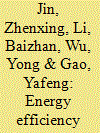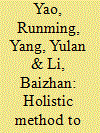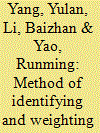|
|
|
Sort Order |
|
|
|
Items / Page
|
|
|
|
|
|
|
| Srl | Item |
| 1 |
ID:
088198


|
|
|
|
|
| Publication |
2009.
|
| Summary/Abstract |
This paper discusses energy consumption, building development and building energy consumption in China, and points that energy efficiency management and maintenance of large-scale public buildings is the breakthrough point of building energy saving in China. Three obstacles are lack of basic statistics data, lack of service market for building energy saving, and lack of effective management measures account for the necessity of energy efficiency supervision for large-scale public buildings. And then the paper introduces the supervision aims, the supervision system and the five basic systems' role in the supervision system, and analyzes the working mechanism of the five basic systems. The energy efficiency supervision system of large-scale public buildings takes energy consumption statistics as a data basis, Energy auditing as a technical support, energy consumption ration as a benchmark of energy saving and price increase beyond ration as a price lever, and energy efficiency public-noticing as an amplifier. The supervision system promotes energy efficiency operation and maintenance of large-scale public building, and drives a comprehensive building energy saving in China.
|
|
|
|
|
|
|
|
|
|
|
|
|
|
|
|
| 2 |
ID:
113438


|
|
|
|
|
| Publication |
2012.
|
| Summary/Abstract |
The assessment of building energy efficiency is one of the most effective measures for reducing building energy consumption. This paper proposes a holistic method (HMEEB) for assessing and certifying energy efficiency of buildings based on the D-S (Dempster-Shafer) theory of evidence and the Evidential Reasoning (ER) approach. HMEEB has three main features: (i) it provides both a method to assess and certify building energy efficiency, and exists as an analytical tool to identify improvement opportunities; (ii) it combines a wealth of information on building energy efficiency assessment, including identification of indicators and a weighting mechanism; and (iii) it provides a method to identify and deal with inherent uncertainties within the assessment procedure. This paper demonstrates the robustness, flexibility and effectiveness of the proposed method, using two examples to assess the energy efficiency of two residential buildings, both located in the 'Hot Summer and Cold Winter' zone in China. The proposed certification method provides detailed recommendations for policymakers in the context of carbon emission reduction targets and promoting energy efficiency in the built environment. The method is transferable to other countries and regions, using an indicator weighting system to modify local climatic, economic and social factors.
|
|
|
|
|
|
|
|
|
|
|
|
|
|
|
|
| 3 |
ID:
101462


|
|
|
|
|
| Publication |
2010.
|
| Summary/Abstract |
This paper describes a method of identifying and weighting indicators for assessing the energy efficiency of residential buildings in China. A list of indicators of energy efficiency assessment in residential buildings in the hot summer and cold winter zone in China has been proposed, which supplies an important reference for policy makings in energy efficiency assessment in buildings. The research method applies a wide-ranging literature review and a questionnaire survey involving experts in the field. The group analytic hierarchy process (group AHP) has been used to weight the identified indicators. The size of survey samples are sufficient to support the results, which has been validated by consistency estimation. The proposed method could also be extended to develop the weighted indicators for other climate zones in China.
|
|
|
|
|
|
|
|
|
|
|
|
|
|
|
|
|
|
|
|
|